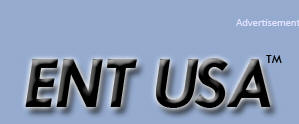|
Paradise Criteria for Tonsillectomy |
View Abstract |
| Criterion
|
Definition |
| Minimum
frequency of sore throat episodes |
7 or more
episodes in the preceding year, OR |
| |
5 or more
episodes in each of the preceding 2 yrs |
| |
3 or more
episodes in each of the preceding 3 yrs |
Clinical
features (sore throat plus the presence
of one
or more qualifies as a counting episode) |
Temperature >
38.3o C, OR 101o F |
| |
Cervical
lymphadenopathy (tender lymph nodes or >2 cm), OR |
| |
Tonsillar
exudate, OR |
| |
Positive
culture for group A b-hemolytic streptococcus |
| Treatment
|
Antibiotics had
been administered in conventional dosage for proved or
suspected |
| Documentation
|
Each episode
and its qualifying features had been substantiated by
contemporaneous notation in a clinical record, OR |
| |
If not fully
documented, subsequent observance by the clinician of 2
episodes of throat infection with patterns of frequency and
clinical features consistent with the initial history |
2.
Hypertrophy
causing upper airway obstruction (sleep apnea) View
Abstract
View
Abstract, severe
dysphagia
(trouble swallowing), sleep disorders, or cardiopulmonary
complications. Usually, removal of both the tonsils and
adenoids are indicated.
3.
Peritonsillar abscess
unresponsive to medical management and
drainage documented by surgeon, unless surgery performed during acute
stage.
View Tonsillectomy Surgery Video
View Drainage Surgery Video
4. Streptococcal Carrier: Chronic or recurrent tonsillitis associated with the
streptococcal carrier state and not responding to beta-lactamase-resistant
antibiotics.
5. Unilateral Enlargement: Unilateral tonsil
hypertrophy
presumed euplastic. Although without other indications (abnormal
appearance, physical examination, symptoms or history) most asymmetries can
be followed conservatively.
View Abstract
Adenoidectomy Alone:
1. Recurrent
acute otitis media
or
chronic serous otitis media.
Adenoidectomy should not be performed with the insertion of the first set of
myringotomy (ear) tubes
unless there is another
indication for adenoidectomy besides chronic
otitis media.
However, repeat surgery for chronic
otitis media
should consist of
adenoidectomy with
myringotomy
(with or without
myringotomy (ear) tube placement.)
View Abstract
Other Indications - (Poorly Validated as of January 2011):
1.
Hypertrophy
(enlargement) causing dental malocclusion or
adversely affecting oral-facial (mouth-face) growth documented by
orthodontist.
2. Persistent foul taste or breath due to chronic tonsillitis not
responsive to medical therapy.
|
Describing Tonsillar Size
Brodsky Grading System
Grade
0: Tonsils within the tonsillar fossa.
Grade
1: Tonsils just outside of the tonsillar fossa, <=25% of the
oropharyngeal width.
Grade
2: Tonsils occluding 26 to <=50% of the oropharyngeal width.
Grade
3: Tonsils occluding 51 to <75% of the oropharyngeal width.
Grade 4: Tonisl occluding greater than 75% of
the oropharyngeal width.
View Abstract |


